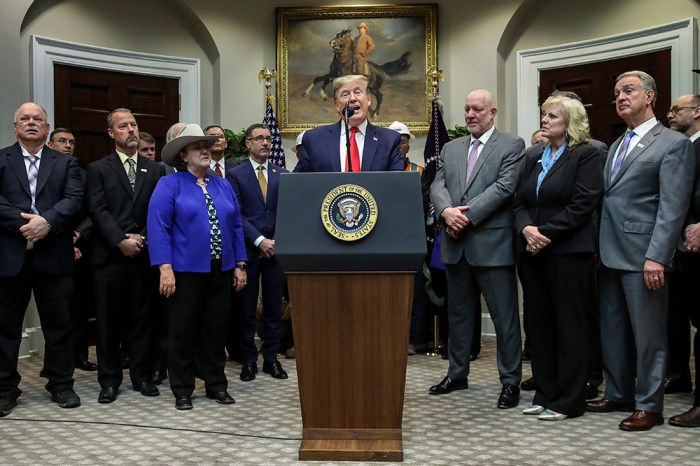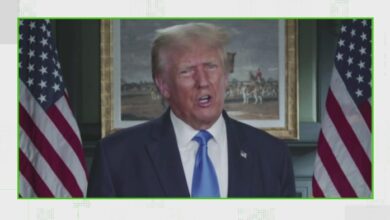
Trump DEI environmental justice: Examining the impact of the Trump administration’s environmental policies on marginalized communities. This exploration delves into the specific actions, justifications, and potential consequences of these policies, analyzing how they disproportionately affected vulnerable populations and exacerbated existing environmental injustices. From rollback of regulations to the potential long-term impacts on ecosystems and human health, this in-depth look will scrutinize the Trump administration’s approach to environmental protection and its impact on environmental justice.
The core of this discussion centers on the concept of environmental justice. It highlights the interconnectedness of environmental issues and social inequalities, demonstrating how policies can have vastly different effects on various demographics. This analysis investigates the complex interplay between Trump’s environmental decisions and their consequences for vulnerable communities. The analysis scrutinizes the stated justifications and potential consequences, drawing connections between environmental policies and the well-being of different communities.
Trump’s Environmental Policies

Donald Trump’s presidency saw significant shifts in environmental policy, marked by a pronounced retreat from previous administrations’ commitments to environmental protection. This shift was evident in numerous actions and pronouncements, impacting various aspects of environmental conservation and management. The administration prioritized economic growth and energy independence over environmental regulations, often citing job creation and economic benefits as the primary justification for these choices.
Summary of Environmental Policies
The Trump administration implemented a series of policies aimed at relaxing environmental regulations, often arguing that these regulations hindered economic development. A central theme was the prioritization of economic interests over environmental considerations. This approach led to a notable rollback of environmental protections, impacting areas such as climate change mitigation, pollution control, and natural resource management.
Climate Change Policies
The Trump administration consistently downplayed the severity of climate change and expressed skepticism about the scientific consensus on the issue. This skepticism translated into actions to weaken or dismantle policies aimed at addressing climate change. The administration withdrew the United States from the Paris Agreement, an international accord to combat climate change, arguing that it imposed unfair burdens on American industry.
Trump’s stance on environmental justice initiatives definitely raised eyebrows. His approach contrasted sharply with the complexities of the Iran nuclear program talks, a subject that was quite prominent during his presidency. For instance, checking out the details of trump iran nuclear program talk reveals the contrasting agendas at play. Ultimately, Trump’s overall environmental justice record remains a subject of debate and discussion.
Furthermore, efforts to promote renewable energy sources were reduced, while fossil fuel industries were given greater support.
Pollution Regulations
Significant rollbacks occurred in pollution regulations, affecting air and water quality standards. The administration eased regulations on power plants, factories, and other industries, leading to concerns about increased pollution levels and potential harm to public health. These actions were justified by the claim that stringent regulations hindered economic growth.
Natural Resource Management
The Trump administration’s policies on natural resource management favored resource extraction and development. This approach was reflected in actions such as loosening regulations on oil and gas drilling, mining, and logging, often citing the need to increase domestic energy production and create jobs. This approach also impacted the protection of endangered species and wilderness areas, as conservation efforts were sometimes scaled back.
Key Environmental Regulations Rolled Back or Altered
| Regulation Name | Agency | Action Taken | Justification |
|---|---|---|---|
| Clean Power Plan | Environmental Protection Agency (EPA) | Withdrawn | “Burdensome on the economy, hindering competitiveness.” |
| Waters of the U.S. Rule | EPA | Revised | “Unnecessarily restricted land use, impacting development.” |
| Endangered Species Act protections | Interior Department | Weakened in certain instances | “Impeding economic development in areas with endangered species.” |
| National Environmental Policy Act (NEPA) | Various Agencies | Interpretations shifted | “Unnecessarily hindering projects.” |
Environmental Justice Concerns
Environmental justice is a critical concept recognizing that marginalized communities disproportionately bear the brunt of environmental hazards and pollution. These communities, often lacking political power and economic resources, face greater risks from industrial facilities, toxic waste sites, and inadequate access to clean air and water. Understanding these injustices is crucial for developing effective and equitable environmental policies.Environmental injustices manifest in various ways, impacting public health, economic well-being, and the overall quality of life for vulnerable populations.
Trump’s stance on environmental justice initiatives often seemed at odds with the needs of vulnerable communities. However, his potential influence on deep-sea mining regulations, as explored in this article about how trump could boost deep sea mining , raises further concerns about the long-term consequences for these communities. Ultimately, these decisions will significantly impact the future of environmental justice in the United States.
The legacy of historical discrimination and systemic inequalities contributes to these disparities. This includes the siting of polluting industries in areas with lower socioeconomic status, leading to higher rates of respiratory illnesses and other health problems. Furthermore, limited access to resources and information exacerbates the challenges faced by these communities.
Identifying Affected Groups
Communities of color, low-income neighborhoods, and Indigenous populations are frequently the most affected by environmental injustices. This is often a result of historical and ongoing discriminatory practices, including redlining, zoning regulations, and the placement of hazardous waste facilities. These communities are frequently subjected to disproportionate exposure to pollutants, leading to adverse health outcomes.
Environmental Issues and Social Inequalities
A strong correlation exists between environmental issues and social inequalities. For example, communities with limited access to healthy food options, clean water, and recreational spaces experience a higher burden of environmental hazards. The lack of green spaces, parks, and recreational areas can limit opportunities for physical activity and contribute to higher rates of chronic diseases. This highlights the interconnectedness of environmental and social factors in shaping health and well-being.
Disproportionate Impact of Environmental Policies
Environmental policies can inadvertently exacerbate existing inequalities. For instance, the decision to locate a new landfill or industrial facility in a marginalized community can have devastating impacts on the health and economic stability of that area. The potential negative impacts on property values, increased risk of disease, and disruption to livelihoods need careful consideration during policy development.
Comparative Analysis of Environmental Policy Impacts
| Policy | Affected Community | Positive Impacts | Negative Impacts |
|---|---|---|---|
| Construction of a new highway | Low-income communities near the highway | Potentially increased economic opportunities, improved transportation access for some. | Increased noise pollution, air pollution, higher rates of accidents, disruption to established communities, potential loss of green spaces, increased property values for others but not necessarily for the communities most impacted. |
| Establishment of a solar farm | Rural communities near the farm | Potential for job creation, renewable energy, increased property values for some, reduced carbon emissions. | Potential for visual impacts, concerns over land use and wildlife, potential for increased property taxes, displacement of communities, potential negative impact on agricultural land for some communities. |
| Siting of a hazardous waste facility | Low-income, minority communities | Potential for job creation, economic benefits, local tax revenue. | Increased health risks, lower property values, reduced quality of life, negative impacts on community well-being, increased exposure to environmental hazards. |
Trump’s Actions and Environmental Justice
The Trump administration’s environmental policies significantly impacted environmental justice issues, often exacerbating existing disparities for vulnerable communities. These policies, frequently driven by deregulation and rollback of protections, raised concerns about the long-term health and well-being of those already facing systemic disadvantages. The potential consequences for air and water quality, access to resources, and public health were substantial, and often disproportionately affected minority and low-income populations.Trump’s environmental policies, particularly those related to weakening environmental regulations, had a clear potential to exacerbate environmental injustices.
Trump’s stance on DEI and environmental justice has been a hot topic lately. Considering the potential fallout from his past actions and statements, it’s interesting to see how his future involvement in the Oval Office might be perceived, especially given recent comments by Johnson regarding the situation. For more insights on this, check out this article about Zelensky, Trump, and the Oval Office fallout: zelensky future trump oval office fallout johnson comments.
Ultimately, the long-term impact on environmental justice initiatives under a Trump presidency remains to be seen.
These policies often prioritized economic growth over environmental protection, leading to a weakening of safeguards that disproportionately affected communities already burdened by pollution and lack of access to clean resources. This trend contrasted with previous administrations’ efforts to address environmental justice issues, highlighting a shift in priorities and approach.
Potential Impacts on Vulnerable Communities
Trump’s environmental policies created significant risks for vulnerable communities, often resulting in diminished air and water quality, reduced access to resources, and compromised public health. For example, rollbacks of regulations regarding emissions from power plants and industrial facilities could have led to increased pollution levels in densely populated, low-income neighborhoods. The effects on public health, including respiratory illnesses and other health problems, could have been considerable and disproportionately affected vulnerable populations.
Access to clean water and safe living conditions was also potentially compromised by weakened protections.
Comparison with Previous Administrations
Previous administrations often prioritized environmental justice in their policies, recognizing the disproportionate impact of pollution on marginalized communities. These policies often included targeted investments in infrastructure, clean energy initiatives, and community-based programs designed to address environmental inequities. The Trump administration’s approach, in contrast, often prioritized deregulation and reduced funding for these programs, potentially reversing progress made in environmental justice initiatives.
Legal and Political Challenges
The Trump administration’s policies faced numerous legal challenges related to environmental justice. Environmental groups and community organizations brought lawsuits arguing that certain policies violated existing environmental laws and the constitutional rights of affected populations. The political landscape also presented significant challenges, with differing perspectives on the role of government in environmental protection and the importance of environmental justice.
These challenges underscore the complexity of addressing environmental justice issues within the political and legal frameworks.
Locations Most Impacted by Trump-Era Environmental Decisions, Trump dei environmental justice
| Location | Policy | Environmental Impact | Community Demographics |
|---|---|---|---|
| Flint, Michigan | Weakening of water quality standards | Increased lead contamination in water supply | Predominantly African American, low-income population |
| Certain rural communities | Relaxation of air quality standards for industrial facilities | Increased particulate matter and other air pollutants | Diverse but often low-income populations with reliance on local industry |
| Coastal communities | Rollbacks of regulations for oil and gas exploration | Increased risk of spills and pollution, coastal erosion | Diverse, including low-income and minority populations often reliant on fishing and tourism |
The table above illustrates potential examples of locations impacted by specific Trump-era environmental decisions. It is crucial to note that this is not an exhaustive list, and the impacts varied significantly depending on the specific policy and local context. These locations and others often bore a disproportionate burden due to existing socioeconomic and demographic factors.
Public Reaction and Opposition
The public response to Trump’s environmental policies, particularly concerning environmental justice, was overwhelmingly negative. Concerns ranged from the potential for increased pollution in marginalized communities to the weakening of regulations designed to protect them. This opposition manifested in various forms, including protests, legal challenges, and public advocacy campaigns.The arguments against these policies were rooted in the belief that they would exacerbate existing environmental inequalities.
Supporters of environmental justice countered that the policies would jeopardize public health, disproportionately harming vulnerable populations. Conversely, some argued that Trump’s policies, while potentially disruptive in some areas, aimed to stimulate economic growth and jobs, ultimately benefiting society as a whole. This led to a complex and often heated debate.
Public Protests and Activism
A significant portion of the public opposition to Trump’s environmental policies took the form of protests and activism. These actions were often organized around the principle of environmental justice, highlighting the disproportionate impact of pollution on marginalized communities. Demonstrations involved a wide range of participants, from individuals to large-scale coalitions. Many of these protests centered on issues like water quality, air pollution, and access to clean energy.
Specific examples included marches, rallies, and sit-ins, all designed to bring attention to the injustices.
Legal Challenges
Numerous legal challenges were filed against Trump’s environmental policies. These lawsuits often argued that the policies violated existing environmental laws or that they would have a discriminatory impact on minority and low-income communities. These legal actions were frequently spearheaded by environmental groups, civil rights organizations, and local communities directly affected by the policies.
Key Organizations and Individuals Involved
Several organizations played crucial roles in opposing Trump’s environmental policies, advocating for environmental justice. Environmental Defense Fund, the Sierra Club, and the Natural Resources Defense Council were among the prominent groups actively involved. At the grassroots level, community activists and local leaders also played vital roles, highlighting the issues facing their communities and mobilizing support.
Different Viewpoints on Trump’s Environmental Policies
| Position | Argument | Supporting Evidence | Relevant Organizations |
|---|---|---|---|
| Opposition | Trump’s policies would worsen existing environmental inequalities, disproportionately harming vulnerable communities. | Studies showing increased pollution levels in minority neighborhoods following policy changes. | Environmental Defense Fund, NAACP Legal Defense and Educational Fund |
| Support | Policies aimed at economic growth and job creation would ultimately benefit all communities, including those facing environmental injustices. | Claims of job creation in certain sectors as a result of policy changes. | Certain business associations, industry groups |
| Neutral | The long-term effects of the policies on environmental justice are uncertain and require further evaluation. | Lack of conclusive data on long-term impacts on specific communities. | Academic research institutions, think tanks |
Long-Term Impacts and Legacy: Trump Dei Environmental Justice
The legacy of the Trump administration’s environmental policies promises a complex and potentially detrimental future for environmental justice. These policies, often characterized by rollbacks of regulations and a disregard for scientific consensus, created a framework that is likely to exacerbate existing inequalities and hinder progress towards a sustainable future. The long-term impacts will be felt across generations and ecosystems, with significant implications for access to clean resources.
Potential Consequences for Future Generations
The erosion of environmental protections under the Trump administration will have profound consequences for future generations. Reduced funding for environmental research and monitoring will lead to a lack of data and understanding of emerging environmental problems. This knowledge gap will make it harder to anticipate and address future environmental challenges, impacting the ability of future generations to enjoy a healthy environment.
For example, the weakening of air quality standards could lead to increased respiratory illnesses and premature deaths in future generations.
Impacts on Access to Essential Resources
Trump-era policies that weakened environmental regulations significantly affected access to clean water, air, and other essential resources for vulnerable communities. The weakening of clean water standards could lead to increased water contamination, impacting public health, especially in communities already facing water insecurity. Reduced oversight of air quality standards could result in more polluted air, negatively impacting the health of those living in areas with high pollution levels.
The legacy of these policies will be a continued and potentially growing struggle for access to vital resources, disproportionately affecting low-income and minority communities.
Changes to Environmental Regulations and their Effect on Vulnerable Populations
The dismantling of environmental regulations during the Trump administration created a regulatory environment that prioritized short-term economic gains over long-term environmental protection. This approach had a particularly detrimental effect on vulnerable populations who often live in areas with environmental hazards. The lasting changes to environmental regulations will result in less protection for these communities and a heightened risk of exposure to environmental hazards, impacting their health, well-being, and quality of life.
For instance, the loosening of standards for industrial emissions could lead to increased air pollution in communities near industrial facilities, exacerbating existing health disparities.
Potential Future Implications
| Policy | Potential Impact | Affected Communities | Mitigation Strategies |
|---|---|---|---|
| Weakening of Clean Water Act standards | Increased water contamination, reduced access to safe drinking water | Low-income communities, communities of color | Strengthening regulations, increased funding for water infrastructure, public awareness campaigns |
| Relaxation of air quality standards | Increased air pollution, adverse health impacts | Urban communities, communities near industrial facilities | Investing in clean energy solutions, promoting public transportation, stricter enforcement of emission standards |
| Reduction in environmental protection funding | Decreased monitoring of environmental hazards, lack of research on environmental problems | All communities | Increased investment in environmental research and monitoring, engaging scientific community, promoting public awareness |
| Reduced enforcement of environmental regulations | Increased environmental damage, less accountability for polluters | Vulnerable populations, communities near polluting industries | Increased funding for environmental enforcement agencies, stricter penalties for violations, public advocacy for stronger enforcement |
Illustrative Examples of Environmental Injustice
Trump’s environmental policies, particularly those related to weakening environmental regulations, disproportionately impacted marginalized communities already burdened by environmental hazards. These policies created and exacerbated existing environmental injustices, leading to significant health and economic consequences for vulnerable populations. This section will delve into specific case studies, highlighting the environmental hazards, health impacts, and historical contexts of these injustices.
Environmental Hazards in Tribal Communities
Indigenous communities often reside in areas with significant environmental vulnerabilities. These areas frequently experience high rates of pollution from industrial facilities, mining operations, and waste disposal sites. This pollution can lead to a variety of health issues, including respiratory problems, developmental disorders, and increased risk of cancer. The historical context of displacement, resource extraction, and limited access to clean water and healthy food compounds these issues.
- The Navajo Nation, located in the southwestern United States, faces contamination from uranium mining and coal ash disposal. This has resulted in high rates of cancer and other respiratory illnesses among the population. The legacy of uranium mining on the reservation has left a significant health and environmental footprint, and the lack of adequate remediation efforts further exacerbates the problem.
- The Standing Rock Sioux Tribe, in North Dakota, faced significant environmental damage due to the Dakota Access Pipeline. The pipeline threatened the tribe’s water supply, sacred sites, and traditional way of life. The protests against the pipeline highlighted the interconnectedness of environmental and social justice concerns.
Pollution in Low-Income Communities
Low-income communities, often located near industrial facilities and waste disposal sites, are disproportionately affected by environmental hazards. These communities frequently lack political power and resources to advocate for their environmental rights, making them more susceptible to pollution and its health consequences. This vulnerability is often rooted in historical patterns of segregation and discriminatory zoning practices.
- Communities of color in the southeastern United States often reside near petrochemical plants and other industrial facilities. Exposure to air and water pollution from these facilities results in elevated rates of respiratory illnesses, birth defects, and other health problems. These communities often lack access to quality healthcare and environmental advocacy resources.
- In the Mississippi Delta, agricultural practices, combined with industrial pollution from nearby facilities, have contaminated water sources, leading to significant health problems for residents. The lack of access to clean water and healthy food has had devastating effects on the community’s well-being. The legacy of agricultural practices in the region and industrial pollution further complicates the situation.
Case Study Comparison
| Case Study | Location | Environmental Hazard | Affected Community | Historical Context |
|---|---|---|---|---|
| Navajo Nation Uranium Contamination | Navajo Nation, Southwestern U.S. | Uranium mining and coal ash disposal | Navajo Nation | Historical displacement and resource extraction by outside entities |
| Standing Rock Sioux Tribe and Dakota Access Pipeline | Standing Rock Reservation, North Dakota | Dakota Access Pipeline construction | Standing Rock Sioux Tribe | Disputes over land rights and sacred sites |
| Southeastern US Communities Near Petrochemical Plants | Southeastern U.S. | Air and water pollution from petrochemical plants | Communities of color | Historical segregation and discriminatory zoning practices |
| Mississippi Delta Water Contamination | Mississippi Delta | Agricultural practices and industrial pollution | Residents of the Mississippi Delta | Historical agricultural practices and industrial development |
Last Recap

In conclusion, Trump’s environmental policies, examined through the lens of environmental justice, reveal a complex tapestry of impacts. The administration’s actions and their consequences for vulnerable communities underscore the critical need for policies that prioritize environmental justice and address the systemic inequalities that exacerbate environmental burdens. This discussion highlights the long-term implications and lasting effects of these decisions on future generations.
Furthermore, the study underscores the importance of considering environmental justice principles in all policy decisions.





